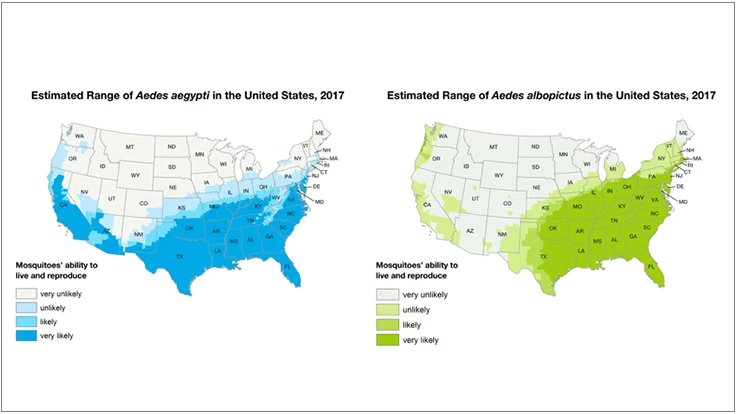
CDC has updated the estimated range maps for Ae. aegypti and Ae. albopictus mosquitoes by using a model that predicts possible geographic ranges for these mosquitoes in the contiguous United States. The model used county-level records, historical records, and suitable climate variables to predict the likelihood (very low, low, moderate, or high) that these mosquitoes could survive and reproduce if introduced to an area during the months when mosquitoes are locally active. These maps include areas where mosquitoes are or have been previously found. Maps do not represent risk for spread of disease. Ae. aegypti mosquitoes are more likely than Ae. albopictus mosquitoes to spread viruses like Zika, dengue, chikungunya and other viruses.
Click to download.
These maps show
*The estimated range maps have been updated using a predictive model that used county-level records, historical records, and suitable climate variables to predict the likelihood (very low, low, moderate, or high) that these mosquitoes could survive and reproduce if introduced to an area during the months when mosquitoes are locally active.
*These maps show CDC’s best estimate of the potential range of Ae. aegypti and Ae. albopictus in the contiguous United States.
*These maps include areas where mosquitoes are or have been previously found.
*Maps do not represent risk for spread of disease.
These maps DO NOT show
*Likelihood that these mosquitoes will spread viruses. Shaded areas on the map do not necessarily mean that there are infected mosquitoes in that area.
*Numbers of mosquitoes: These maps do not show how many mosquitoes are living in an area. Mosquito population numbers vary widely across the shaded areas on the map, from high numbers of mosquitoes in some parts of the contiguous United States to rare reports of mosquitoes further north.
*Exact locations of mosquitoes: These maps are CDC’s best estimate of where mosquitoes could potentially live. *Actual mosquito populations will vary by state and county. Mosquito populations may be found in an area that is not shaded on the maps and may not be found in all shaded areas.
*CDC is not able to predict exactly how much Zika or other viruses spread by Ae. aegypti or Ae. albopictus could spread if and when local mosquito-borne transmission is detected.
Latest from Pest Control Technology
- Donny Oswalt Shares What Makes Termites a 'Tricky' Pest
- Study Finds Fecal Tests Can Reveal Active Termite Infestations
- Peachtree Pest Control Partners with Local Nonprofits to Fight Food Insecurity
- Allergy Technologies, PHA Expand ATAHC Complete Program to Protect 8,500 Homes
- Housecall Pro Hosts '25 Winter Summit Featuring Mike Rowe
- Advanced Education
- Spotted Lanternflies, BMSBs Most Problematic Invasive Pests, Poll Finds
- Ecolab Acquires Guardian Pest Solutions





